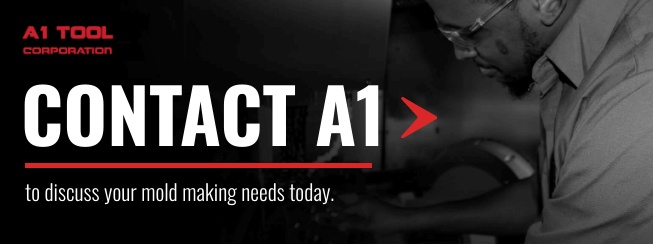How a Stack Mold Improves Injection Molding Productivity
There are several types of injection molding processes. One of them is called stack molding. A stack mold is, simply stated, a series of interconnected, same-sized, single-face molds. In other words, stack molding involves “stacks” of two or more mold parting surfaces stacked together in parallel layers of cavity grids. Unlike traditional molds, which consist of a core and cavity, stack molds use a stack of multiple core and cavity mold layers.
The leading advantage of stack molding is greater productivity. The process allows multiple pieces to be produced at one time during the same injection molding cycle on the same machine. Molds can be stacked with multiple plates, typically, two, three or four. This approach doubles, triples or quadruples production capacity. For example, a stack mold with four-plus-four cavity grids will result in eight copies per cycle.
Stack Molding Delivers Multiple Benefits
Along with increased output, stack molding delivers additional benefits, including increased output without increased tonnage, lower operational costs, and versatility for multiple uses.
Productivity is enhanced, not only due to greater production capacity but also because the increased production quantity does not increase the clamping force of the injection machine. In other words, stack molding allows operations to mold all parts in the stack in one shot with the same amount of clamp force tonnage, whether producing one-level or multi-level stack molds. The reduction in tonnage with an increase in output means each part costs less to produce.
Stack molding lowers operational costs thanks to greater efficiencies and faster cycle times. Although output is increased, there is no corresponding increase in mold or machine size. Also, fill, pack and cooling times remain the same, since the area involved is the same.
Stack Molding Delivers Multiple Uses
While the most common use case for stack molding is to create identical copies, it’s not the only use. In fact, stack molding supports opportunities for versatility thanks to the nearly limitless applications of the stacking process, for example:
- Stack molding removes the need to make several runs in order to create parts for a product
- Cavity grids can be made to create several different parts for one finished product in one run
- Stack molding will also support multiple material injections, allowing for a broad set of possibilities
A study on stack molding found that, while stack molds are often recommended for the injection of mass consumption parts, they support other applications, as well. For example, the research found that stack molding is also a great option for molding pieces with more complex shapes, even with some additional complications. Because twice the number of pieces are produced in the same cycle time, the investment will be easily recovered.
Common Misconceptions About Stack Molding
While stack molding offers significant benefits, some companies don’t leverage its full potential. This is usually due to three common misconceptions about stack molding. Many operators believe it’s difficult to set up, maintenance is hard, and lubricating the stacks is a hassle. But to gain the benefits of stack molding, it’s time to overcome these misunderstandings.
- Misconception: Difficult to set up. Setting up stack molds requires operators to follow a step-by-step process according to the manufacturer's specifications. However, there are few differences compared to setting up single-stack molds. Both require simple, but systematic, processes. For stack molding, one experienced person should be able to set up the entire assembly in about 30 minutes on average.
- Misconception: Maintenance is hard. This misunderstanding came from the fact that multiple molds require more maintenance time than a single mold, and also that multiple moving parts mean additional service and maintenance. However, in reality, maintaining multiple molds to keep them functioning smoothly and avoid wear and tear is not more challenging than maintaining a single mold, as long as the configuration allows easy access for cleaning.
- Misconception: More lubrication is required. Regularly lubricating the parts of the molds is a normal part of maintenance, because it enhances service and lowers the risk of breakdowns. For example, to keep the side gear mechanism opening and closing smoothly requires regularly applying lubrication. This is typically accomplished with an easy and fast oil sprayer.
Stack plastic injection molds were introduced in the 1960s, and A1 Tool was instrumental in pioneering their development. If you are planning for a future expansion or want to reduce costs, consider A1’s strengths in complex, multi-shot, multi-action stack and tandem molds.
When selecting a vendor for your stack tool, be sure to select a reputable and experienced vendor. Mold sag and alignment, if not engineered correctly, will cause tolerance variations and flaws. A1 Tool has engineered a center support structure proprietary to their stack molds which ensures alignment and eliminates sag. Bring us your project and we’ll help evaluate if a stack mold is right for you.











